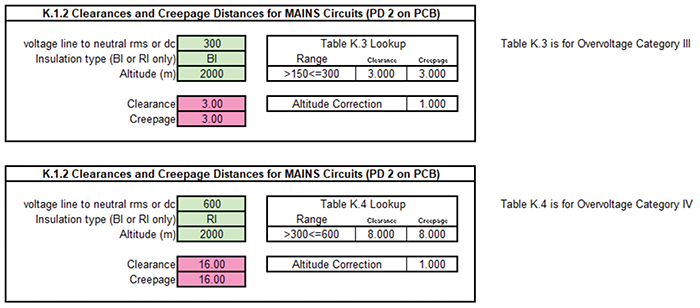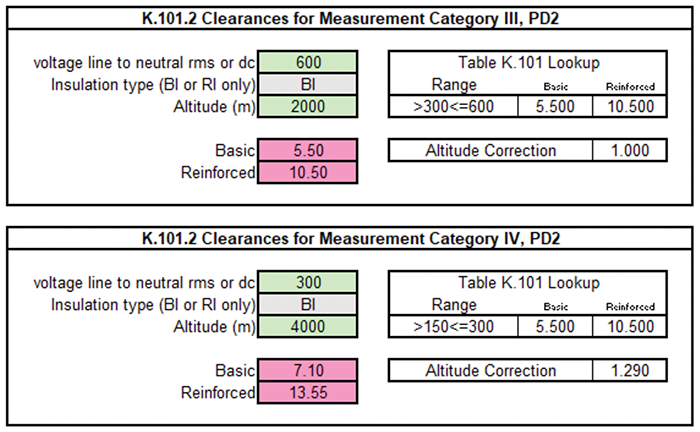Introduction
The calculation of creepage and clearance distances (spacings) is one of the most important activities a product safety/compliance engineer or technician performs throughout the product development process. Conducting this activity sooner rather than later is key to releasing a product on time and within schedule and budget constraints. Waiting to calculate creepage and clearance distances until the prototype stage, when safety evaluation and testing have begun, is almost always a recipe for disaster. Correcting spacing miscalculations late in the product development cycle will assuredly add unnecessary redesign and retest efforts, increase the risk of delaying production release until the issue is addressed, or even releasing the product without the necessary product safety approvals.
If you work on a technically savvy design team, they will likely turn to you for help in determining the appropriate spacings for the product far in advance of ordering any prototypes. If they do not come to you for help, then it would be wise to take the lead and supply this information even if not requested.
If you are unsure what I’m talking about, this article highlights what is involved in calculating creepage and clearance distances using a spacings calculator and provides recommendations for managing this activity on any future projects.
Determination of Applicable Safety Standard(s)
The first step in determining the correct creepage and clearance distances for your product is identifying which safety standard(s) apply to it. The product specification may include the required standard(s), but if not, you can determine the applicable standard in several ways.
The first way is to consult with the third-party certification agency (Nationally Recognized Test Laboratory – NRTL) involved in the certification of your product. The NRTL will have a good idea of which standard(s) applies to your product.
Another method is to look at the specifications for existing products your company produces. The new product will likely have similar installation conditions and functions and have very similar safety requirements.
Finally, if these other two options don’t pan out, you can always search online for similar products and see what safety standard(s) those products meet.
Determination of Use Environment
Once the appropriate safety standard is identified, the next step is to determine the pollution degree, overvoltage category, altitude rating, measuring category (if applicable), material group for printed circuit board material, and voltage rating for the system (Voltage Line-to-Neutral–AC, RMS, or DC). You will need to know what type of circuit you will be determining spacings for (i.e., Mains circuits or other). Consult references one and two for the meaning of these terms.
Spacings Calculator
Product safety standards often have multiple creepage and clearance tables to help determine the appropriate spacing values even when provided with a narrow list of information, as mentioned above. The tables are often spread out in several locations which can make finding the correct spacings for a circuit time-consuming and cumbersome. The back-and-forth process of looking at specifications and then the spacings tables and then back again has the potential to lead to confusion which could result in providing an incorrect creepage or clearance number when the pressure is on, and the design team is requesting the numbers. To make the process easier, faster, and more accurate, we highly recommend constructing a spacings calculator. It is based on the standard’s creepage and clearance tables but makes it easier to pin down spacing numbers in a much more timely and efficient manner. The NRTL you’re working with may also be able to provide a spacings calculator you can use, eliminating the need to create your own.
But, if you’re curious like most of my fellow engineers, the rest of this article describes how to create your own spacings calculator.
Using a spreadsheet program like Microsoft Excel, recreate the information for each creepage and clearance table from the standard and use the lookup function to find the correct spacings given the various inputs provided by the design team.
Sometimes the standard(s) allows interpolation for spacing values that fall between two voltages but do not land directly on the voltage identified in the spacings table. In this instance, you will have to include the interpolation calculation as part of the lookup. You can use many resources online if you don’t already know how to perform interpolation in Excel.
Once the tables from the standard(s) are entered, and you confirm the lookup function is working correctly, you can use the hide feature in Excel to hide the tables from view.
You will also want to create an esthetically pleasing area in which to enter information and obtain the output (i.e., correct spacings number). For spacings calculators I have created, I have made it so the entering of appropriate inputs is identified by green boxes, and where the results (in mm) are read from are identified by red boxes. Any grey boxes are those where the information is left unchanged.
Below are example outputs of a spacings calculator created based on UL/IEC 61010-1 and IEC/UL 61010-2-030.




Pro Tip 1: For each of the spacings outputs, include lots of notes that will help you remember what the calculation pertains to and how it was derived. This especially comes in handy if you do not use the spacings calculator tool every day. Notice in the above outputs notes are included where appropriate and that the clause(s) from the standard(s) the calculation pertains to is indicated. Also included are the table numbers the information is pulled from. All of this information will come in handy if you ever need to refer back to the standard for clarification, such as when the spacings numbers calculated are questioned.
Pro Tip 2: A similar process as documented above can be used to help calculate AC Voltage (High-Potential, “Hipot”) and Impulse test voltages. These numbers are often as confusing to figure out as spacings, and they go hand in hand with them. Hipot and Impulse test voltages are applied during product safety testing to prove the insulation has the proper creepage and clearance values.
Summary
Determining correct spacings as part of product development can be a time-consuming and error-prone process. Developing and using a spacings calculator as part of your normal duties as a product safety/compliance engineer/technician makes life much easier. Going through the process to create your own spacings calculator and incorporating its use into your compliance engineering back of tricks is highly recommended. For more information on spacings, please see the following:
References and Further Reading
- EN/IEC/UL 61010-1, Standard for Safety—Electrical Equipment for Measurement, Control, and Laboratory Use; Part 1: General Requirements.
- EN/IEC/UL 61010-2-030, Standard for Safety—Requirements for Electrical Equipment for Measurement, Control, and Laboratory Use – Part 2-030: Particular Requirements for Equipment Having Testing or Measuring Circuits.
